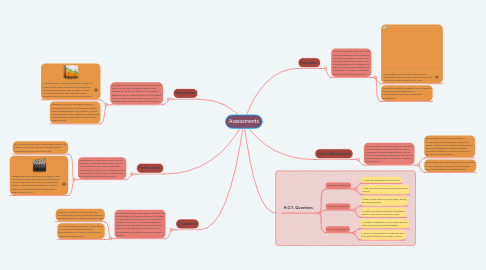
1. Summative
1.1. Summative assessments are given near the end of a unit and compares against the standards set by the state or benchmarks. These types of assessments come at higher risks for students and require planning on both the instructors part and the students.
1.1.1. A final project may be assigned to students to show their learning over the information learned in either the class or unit. A rubric can be provided by the teacher to help students plan the information they provide.
1.1.2. Students may also be asked to give a presentation over a unit to demonstrate their understanding of the topic. A rubric may be given to the student to help guide the information they are to cover in the presentation.
2. Performance
2.1. Depending on the class in question, an instructor may use performance as an assessment of skills and knowledge acquired from the class. A student must physically or orally to demonstrate the information learned in the class.
2.1.1. A musical class may require the students to perform a solo at a recital to demonstrate their skills learned from the class.
2.1.2. Theater students may have compose a skit and direct a short performance at the end of the school year as a final performance project. This would demonstrate various aspects of what had been taught over a long period of time.
3. Diagnostic
3.1. Diagnostic assessments allow a teacher to see growth from before a lesson is taught to after the lesson occurs. This can help a teacher determine any misconceptions that may not had been voiced during the lesson. It can also tell of an individual's weaknesses, strengths, and or a student's abilities.
3.1.1. Diagnostic testing can help identify students who may have special needs or can be identified as 'gifted and talented'.
3.1.2. Pre and Post assessments can be given over a lesson to determine the effectiveness of a lesson and help an instructor gather data.
4. Formative
4.1. Monitor students learning as the lesson progresses and comes at low risks to students. Instructors can give real time feedback and make adjustments as needed for any unforeseen misconceptions during the process of gathering evidence of student learning.
4.1.1. One-Pagers are activities done by the student to use a create mean to assess the students understanding of a topic.
4.1.2. Class discussions is another time a teacher can assess their students for understanding and use scaffolding techniques.
5. Interim/Benchmark
5.1. Interim/Benchmarks are given to students to assess their understanding on state standards that have been taught. These forms of assessment are given at intervals throughout the year, especially in testing grade levels.
5.1.1. Benchmarks can be given either by computer or the traditional method of paper. Districts can provide these tests by topics to determine where the grade level(s) standing on a topic is such as in the area of Mathematics.
5.1.2. Benchmarks can also assess the probability of the students chances at passing the state issued tests as a released test.
6. H.O.T. Questions
6.1. Opening Questions:
6.1.1. 1. How do we keep track of time?
6.1.2. 2. Do you remember what time we go to lunch?
6.2. Guiding Questions:
6.2.1. 1.What observations do you have about the analog clock?
6.2.2. 2. What are the differences between a digital clock and an analog clock?
6.3. Closing Questions:
6.3.1. 1. Create a schedule of your daily life and note at what time things happen.
6.3.2. 2. Why is it important to keep track of time and know how to read a clock?

